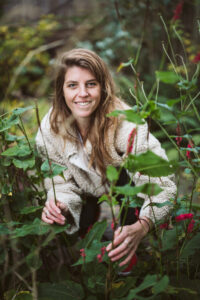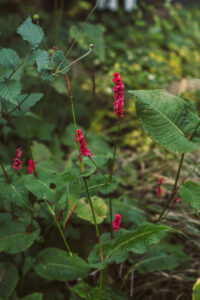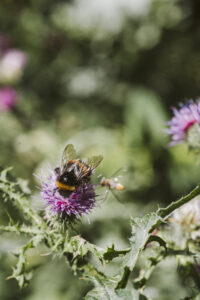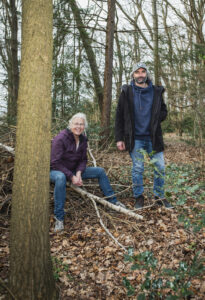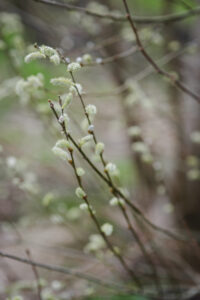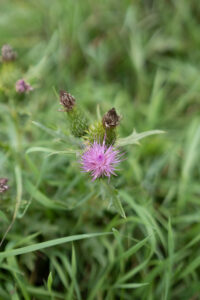Wouter van Eck
Activities:Agroforestry
Founder:Wouter van Eck
Launched:2009
Location:Groesbeek

Introductie
We either talk about nature or about agriculture. This separation has led to many issues, amongst them the nitrogen crisis, according to Dutch food forest farmer Wouter van Eck. To change the tide, he shows how we can unite food production and conservation on the same plot. “It’s time to abandon the false dichotomy between ecology and farming”, he asserts. “In doing so, we can establish a completely new food system.”
 A pawpaw tree in food forest Ketelbroek. Photographer: Gabriela Hengeveld
A pawpaw tree in food forest Ketelbroek. Photographer: Gabriela Hengeveld
“People often believe that farmers around protected nature reserves need to vacate their lands, due to the burden they place on the ecosystems, but this is simply not true. Their agricultural practices just need to become compatible with those natural environments”, according to ecologist and food forest farmer Wouter van Eck. He is stunned that the Dutch government, in addressing the nitrogen crisis, is completely overlooking agroforestry as a sustainable alternative for dairy farms. “Food forests have zero emissions and support fragile ecosystems instead of harming them. Therefore, rather than expropriating farmers from their lands, we actually have the opportunity to convert 170,000 hectares into food forests.”
In the 1990s, Wouter first encounters a food forest whilst conducting research in Kenya. “It was a lush, paradise-like place, with mango and avocado trees combined with smaller papaya trees and coffee and tea growing in the shaded edges”, he recalls. “Whilst I walked around, I immediately knew the place functioned like a natural forest, but was in fact man made. Because the avocado originally stems from central America and the mango tree comes from India and Bangladesh. This got me thinking on how food forests could work in the Netherlands.”
Uitgelichte quote
Nature wants to be generous: we just need to give her a chance
 An aerial view of food forest Ketelbroek. Photographer: Gabriela Hengeveld
An aerial view of food forest Ketelbroek. Photographer: Gabriela Hengeveld
Food forest Ketelbroek
After years of relentless campaigning against industrial livestock farming and pesticides, in 2009 Wouter finally decides to act upon his food forest plans. Together with Pieter Jansen, he buys a cornfield of 2,5 hectares in a small Dutch town called Groesbeek and gets to work. “We started planting edible trees, hedges and shrubs, introduced elevation and created a meandering stream for frogs and toads.”
Since then, nature has come back with incredible resilience. The food forest, in which some trees now stand over 15 meters tall, is the home to over 30 bird species, weasels, fireflies, grass snakes and even beavers. In addition, it houses more moth species than the nearby protected Natura-2000 reserve. “It’s like Noah’s Ark full of animals who have come to take shelter in an otherwise barren agricultural landscape”, Wouter says. “And the harvests become more bountiful every year. Nature wants to be generous: we just need to give her a chance.”

From farm to food forest
Establishing a food forest requires an initial investment, due to the planting costs, but as soon as it matures, it becomes financially viable, researchers of the HAS University of Applied Science conclude. “This is because you have zero costs for fertilizers, pesticides, fossil fuels or machinery, nor do you need to resow and replant every single year”, Wouter explains. However, because it takes about seven years before you start to see a proper return, farmers who want to convert their land should do so gradually, he emphasizes.
Through his foundation, Wouter supports this transition. “We work together with farmers who are willing to commit a minimum of five hectares for at least 20 years. Together, we obtain the necessary permits and create a design”, he says. “Some farmers wish to integrate sustainable tourism, then it’s nice to have lots of summer fruits, whilst others prefer to make their own apple cider or walnut oil. In any case, there are about 100 edible trees and plants that work well in food forests and are suitable for the Dutch climate, so there are plenty of options.”
Uitgelichte quote
Every time you start to worry, nature comes with a solution
 Wouter van Eck in his natural habitat. Photographer: Gabriela Hengeveld
Wouter van Eck in his natural habitat. Photographer: Gabriela Hengeveld
 Wild gooseberries in food forest Ketelbroek. Photographer: Gabriela Hengeveld
Wild gooseberries in food forest Ketelbroek. Photographer: Gabriela Hengeveld
Inner and outer change
Farmers should be financially rewarded for planting trees, increasing organic matter in their soils and restoring biodiversity on their lands, Wouter argues. “However, right now, the Dutch government spends 900 million euros per year on perpetuating industrial livestock farming and monocultures”, he says. “Imagine what would happen if we actually aligned these subsidy streams with governmental policy goals.”
Wouter also emphasizes the need for an inner shift. Because as long as we feel the need to control ‘pests’, like aphids and caterpillars, the birds and insects who provide natural pest control will never arrive. “In other words, you need the ‘pest’ to attract the predator. And every time you start to worry, nature comes with a solution.”
Originally published on the 17th of August 2022. Translated on the 25th of June 2024 by Nadine Maarhuis.

